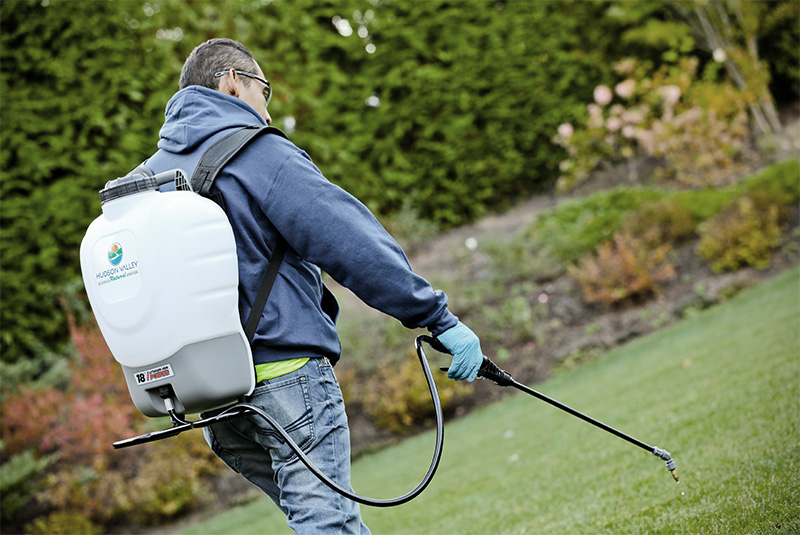Whether you’re responsible for a customer’s lawn, a sports field, or a golf course, maintaining a healthy, pest-free turf requires a strategic combination of insecticide applications and soil fertility management. Let’s explore granular and liquid insecticide options, their timing based on phenological indicators, and the benefits of using Hudson Valley Natural Fertilizer for sustainable fertility management. The recommendations provided apply across various regions, ensuring optimal turf health.
Insecticide Options for Turf
Granular Insecticides
Granular insecticides are easy to apply and work best when watered in to penetrate the soil. These are commonly used for preventative or curative and long-term control of turf pests.
1. Imidacloprid (e.g., Merit, Mallet, Imidacloprid .5G)
- Application: Granular, watered in after application
- Target Pests: Grubs (Japanese beetle larvae, European chafer)
- Advantages: Systemic action for long-lasting control, effective against subsurface pests
- Timing: Apply in June-July before egg hatch; monitor turf for adult beetle activity.
2. Chlorantraniliprole (e.g., (Durentis/Acelepryn Combo Products)
- Application: Granular, applied early season
- Target Pests: Grubs, sod webworms, billbugs, cutworms
- Advantages: Season-long protection, low impact on beneficial insects
- Timing: Early spring application before soil temperatures exceed 55°F.
3. Bifenthrin (e.g., Talstar G, Bifen LP)
- Application: Granular, surface applied
- Target Pests: Ants, fleas, ticks, chinch bugs
- Advantages: Residual control, effective against surface insects
- Timing: Apply when temperatures reach 65°F in spring to manage early outbreaks.
Liquid Insecticides
Liquid formulations are best for preventative or curative treatments and surface-feeding insect control. Synthetic chemicals can offer broad-spectrum control and fast action, especially in high-pest pressure situations. Judicious use of NEONICOTINOID and PYRETHROID insecticides is imperative.
1. Chlorantraniliprole (e.g., Durentis)
- Application: Liquid spray
- Target Pests: Grubs, armyworms, cutworms, sod webworms
- Advantages: Season-long protection, low impact on beneficial insects.
- Timing: Early spring application before soil temperatures exceed 55°F.
2. Trichlorfon (e.g., Dylox)
- Application: Liquid, watered in
- Target Pests: White grubs, sod webworms
- Advantages: Rapid curative control
- Timing: Late summer or early fall when grub activity peaks.
3. Gamma-cyhalothrin (e.g., Scion)
- Application: Liquid spray, surface applied
- Target Pests: Ants, fleas, ticks, mosquitoes, surface feeders
- Advantages: Fast action, residual control
- Timing: Use when temperatures exceed 45-50°F, often in early spring.
Phenological Indicators for Proper Timing
Using phenological indicators (plant development cues) aid insecticide application preparations based on historical pest emergence patterns.
- Forsythia Bloom (Early Spring) – Apply Durentis for grub prevention when yellow Forsythia flowers are in full bloom. Hudson Valley Natural Jackpot w/Dimension & Acelepryn is a great Fertilizer combination product for this timing and control.
- Flowering Dogwood (Mid-Spring) – Target Chinch Bugs primary applications when Dogwood is in full bloom. Aloft LC or Arena 50WDG are options.
- Growing Degree Days (GDD 150-200, Late Spring) – Apply Bifenthrin for surface pests, such as Chinch Bugs, ticks, .. as soil temperatures reach 65°F.
- GDD 500-600 base 32 (Early Summer) – Apply Imidacloprid or Chlorantraniliprole for grub control before peak egg hatch. Hudson Valley Natural IMI-Lambda Combination control products will provide turf nutrition, grub control, and surface feeding insect control.
- First Frost (Fall) – Use Carbaryl or Dylox for curative grub treatments. Curative grub treatments can begin as early as September in certain regions. A planned grub preventative program will alleviate curative treatments.
Fertilizer Options for Turf Health
Hudson Valley Natural Fertilizer: Sustainable Turf Care
Using natural and organic fertilizers enhances soil biology and grass resilience, reducing the need for chemical insecticides.
1. Hudson Valley Jackpot 17-0-4 *
- Best For: General turf maintenance, slow-release nutrition
- Advantages: Enriches soil microbial life, improves drought tolerance
- Application Timing: Spring and fall to sustain healthy root development.
2. Hudson Valley Flex 7-0-5*
- Best For: High-traffic areas, summer feeding
- Advantages: Provides steady nitrogen supply without excessive growth
- Application Timing: Late spring to early summer when turf enters peak growth.
3. Hudson Valley 15-15-5 Starter Fertilizer
- Best For: New turf establishment, overseeding
- Advantages: Phosphorus-rich formula boosts root growth
- Application Timing: Early spring or fall for new seeding projects.
4. Hudson Valley Defender 10-0-15 Potassium Boost*
- Best For: Strengthening turf for winter dormancy
- Advantages: Enhances disease resistance, reduces winter stress
- Application Timing: Late summer to early fall.
*Hudson Valley Fertilizer are available with insecticide control.
Integrated Pest and Fertilization Management Table
| Insecticide (Active Ingredient) | Application Method | Target Pests | Advantages | Phenological Indicators |
| Imidacloprid (Merit, Mallet, IMI-Lambda) | Liquid & Combo | Grubs, Surface | Effective preventative control, systemic action | Apply June-July; monitor beetle flights |
| Chlorantraniliprole (Acelepryn, Durentis) | Liquid & Combo | Surface/subsurface pests | Season-long control, low impact on beneficials | Apply early spring, Forsythia bloom |
| Bifenthrin (Talstar) | Liquid & Combo | Ants, ticks, chinch bugs | Residual surface control | Apply when soil reaches 65°F in spring |
| Carbaryl (Sevin) | Liquid | Grubs, armyworms | Fast-acting, broad spectrum | Mid-August to September |
| Trichlorfon (Dylox) | Liquid | White grubs | Curative control | Late summer or early fall |
| Gamma-cyhalothrin (Scion)
|
Liquid | Ants, fleas, ticks, mosquitoes | Strong residual barrier | Spring, soil temps above 45-50°F |
Conclusion
For optimal turf health across the U.S., combining granular and liquid insecticides with Hudson Valley Natural Fertilizer ensures effective pest control and sustainable fertility management. Aligning applications with phenological indicators further enhances efficiency, reducing pesticide use while maintaining healthy turf throughout the seasons. Understanding the insecticide active ingredient options determines the aptness for controlling specific pests. Choosing the right active ingredient requires an understanding of what insects it controls while determining what risks the product may pose to non-target organisms and the environment you’re treating. As always, follow the label instructions to ensure you’re applying the product at the correct rate.

